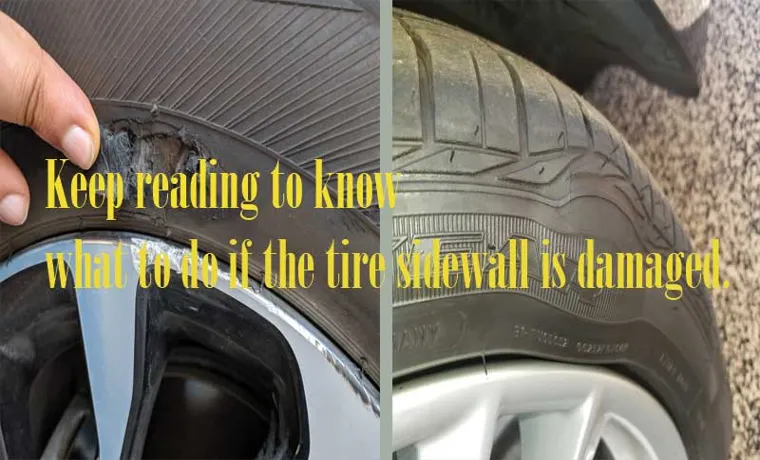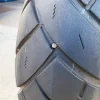Have you ever noticed a strange bulge or crack on your tire sidewall? This is one of the most common signs of tire damage that should not be ignored. Damage to the sidewall poses a serious risk to the safety of your vehicle and passengers. So, when should you replace your tire? If you can see any visible signs of damage or a bulge on the sidewall, it’s time to replace your tire.
Cracks, cuts or punctures to the sidewall can cause significant damage to your tire, which could lead to a sudden blowout. Additionally, if the bulge continues to grow, it can cause a compromise in the tire’s integrity, making it more susceptible to a blowout. Driving with a damaged tire is like walking on a tightrope – it’s dangerous and could lead to disastrous consequences.
It’s best to have a reliable mechanic assess the damage and recommend the appropriate action to take. Your tire may need to be replaced, or it might just need to be patched up. In conclusion, any sign of tire sidewall damage is a cause for concern.
It’s essential to be proactive and have a professional check your tires’ condition regularly. Knowing when to replace a damaged tire could save you from an accident or breakdown in the future. Keep your vehicle safe by taking care of your tires!
Table of Contents
What Causes Tire Sidewall Damage?
Tire sidewall damage is a common issue that can occur for a variety of reasons. One cause is hitting a curb or pothole, which can bend or dent the wheel and cause the tire to bulge. Age is another factor that can contribute to sidewall damage – as a tire gets older, the rubber can become brittle and crack, making it more susceptible to damage.
Exposure to sunlight and extreme temperatures can also weaken the sidewall over time. Additionally, improper inflation can put excessive stress on the sidewall, leading to damage over time. No matter the cause, it’s important to regularly inspect your tires for signs of sidewall damage, such as bulges or cracks, and replace them promptly to ensure your safety on the road.
Road Hazards
Tire sidewall damage is a common problem for many drivers and can result in costly repairs. It can be caused by a variety of road hazards such as potholes, rocks, and curbs. When your tire hits these hazards at high speeds, the sidewall can bulge or crack, resulting in a blowout.
Driving on underinflated tires can also cause sidewall damage since they are more susceptible to punctures and cuts. It’s important to inspect your tires regularly for signs of sidewall damage. Look for bulges, cracks, or punctures and replace the tire immediately if you find any damage.
It’s also essential to ensure that your tires are properly inflated and have the correct tire pressure. Overinflated or underinflated tires can cause uneven wear and damage to the sidewalls, leading to potential safety hazards. It’s a good idea to always keep a spare tire in your car in case of a blowout or other tire emergencies.
In conclusion, tire sidewall damage can be caused by a variety of road hazards and can lead to costly repairs and safety hazards. Regular inspections and proper tire maintenance are key to preventing sidewall damage and ensuring safe driving. By regularly checking your tires and replacing damaged tires promptly, you can avoid potentially dangerous situations on the road.

Age and Wear
Tire sidewall damage can be caused by a variety of factors, but one of the most common is age and wear. Over time, the rubber in tires can become brittle and crack, which weakens the sidewalls and makes them more vulnerable to damage from impacts or road hazards. In addition, tires that have been driven for thousands of miles can develop bulges or bubbles on the sidewalls, which are often the result of internal damage to the tire.
This is particularly true for tires that have been driven on underinflated or overloaded, as these conditions can put additional stress on the sidewalls. To prevent sidewall damage, it’s important to regularly inspect your tires for signs of wear and tear, and to replace them when they are past their prime. This will not only improve the safety of your vehicle but also ensure optimal performance and fuel efficiency.
Impact Damage
When it comes to tire damage, sidewall issues can be particularly concerning. Impact damage is one of the most common reasons for sidewall damage to occur. This can happen when your tire hits a curb, pothole, or other debris on the road.
The force of the impact can cause tears, cuts, or punctures to the sidewall, which can compromise the structural integrity of your tire. Additionally, impact damage can cause bulges or blisters to form on the sidewall, which can be dangerous if left unaddressed. It’s important to inspect your tires regularly for signs of impact damage, even if you don’t notice any symptoms while driving.
By catching and addressing sidewall damage early, you can help prevent further damage to your tire and ensure your safety on the road.
Identifying Tire Sidewall Damage
Tire sidewall damage is a common issue that many drivers face. It can be caused by a variety of factors, including potholes, curbs, and sharp objects on the road. Identifying the damage on your tire’s sidewall can be tricky, but it’s important to do so as quickly as possible to avoid any potential accidents down the road.
Signs of damage may include bulges, cracks, or cuts on the sidewall. If you notice any of these signs, it may be time to replace your tire. Driving on a damaged tire can be dangerous, as it can lead to a blowout or other safety hazards.
When in doubt, it’s always best to take your vehicle to a trusted mechanic to have your tires inspected. Remember, ensuring your tires are in good condition is essential for safe driving and peace of mind on the road.
Cracks and Scratches
Identifying tire sidewall damage can be crucial for ensuring your safety on the road. One of the most common forms of damage is cracks and scratches on the sidewall. These can occur due to various reasons such as overloading, underinflated tires, and prolonged exposure to UV radiation.
If the cracks or scratches are deep enough, it can cause damage to the internal components of the tire and lead to a blowout. To identify these, inspect your tires regularly and look for any visible lines or bulges on the sidewall. Additionally, feel for any roughness or bumps by running your hand over the sidewall.
If you spot any of these signs, it’s best to get your tire checked by a professional mechanic. Remember, small cracks and scratches can worsen over time, so it’s always better to be safe than sorry.
Bulges and Blisters
Tire sidewall damage can be a hazardous issue. One of the most common types of tire sidewall damage is bulges and blisters. They are typically caused by hitting curbs, potholes, or other road hazards.
Identifying them can be easy as you can visibly see a bulge or blister on the sidewall. Driving with bulges or blisters is not safe. They can pop or rupture, which can cause a blowout leading to an accident.
It’s essential to inspect your tires routinely, looking for any bulges or blisters. If you spot anything, have your tire inspected as soon as possible by a professional. A stitch in time saves nine!
Exposed Cords
If you notice exposed cords on your tire’s sidewall, it’s important to take action immediately. Exposed cords occur when the rubber of your tire wears away, and the metal cords underneath become visible. This not only compromises the integrity of your tire but also makes it more prone to blowouts and punctures.
If you notice this type of damage, don’t try to repair it yourself. Take your vehicle to a professional mechanic to have the tire evaluated. They can advise you on whether you can still use the tire or if it needs to be replaced.
Remember, driving on a damaged tire can be dangerous and potentially life-threatening. It’s always better to err on the side of caution when it comes to your safety on the road.
When to Replace a Damaged Tire
Tire sidewall damage can be a tricky thing to navigate. Depending on the severity of the damage, it may be possible to repair the tire, but oftentimes replacement is necessary. One of the most common types of sidewall damage is a bulge, which is caused by a weak spot on the tire.
This can happen due to hitting a curb or pothole, or even just from wear and tear. If you notice a bulge on your tire, it’s important to replace the tire immediately. Driving on a damaged tire can lead to a blowout, which can have serious consequences.
Another type of sidewall damage is a cut or tear. If the cut or tear is deep enough, replacement is necessary. However, if it’s a smaller cut or tear, it may be possible to repair the tire.
In any case, it’s important to have a professional inspect the tire to determine the best course of action. Overall, it’s better to err on the side of caution when it comes to sidewall damage. If you’re unsure whether your tire needs to be replaced, it’s always best to seek the advice of a trusted professional.
Severity of Damage
When it comes to tire damage, it’s important to understand the severity of the issue to determine whether it’s time to replace your tire or if it can be repaired. Minor damages, such as small punctures or cuts on the sidewalls, can often be repaired by a professional technician. However, if the damage is more severe, such as a large puncture or a bulge in the sidewall, it’s usually best to replace the tire altogether.
It’s also important to be aware of the age of your tire, as tires that are over 6 years old can be more prone to damage and deterioration. Remember, safety should always be a top priority when it comes to your vehicle, so don’t delay in getting a damaged tire replaced when necessary.
Location of Damage
When considering whether or not to replace a damaged tire, one of the factors to take into consideration is the location of the damage. If the damage is located in the tread area of the tire, it may be possible to have the tire repaired. However, if the damage is in the sidewall or shoulder of the tire, it is usually recommended to replace the tire entirely.
This is because damage in these areas can weaken the structure of the tire and compromise its ability to perform properly. Additionally, damage to the sidewall can be dangerous as it can cause a blowout while driving, which can result in a loss of control of the vehicle. It’s always best to have a professional inspect the tire and make recommendations for repairs or replacement to ensure optimal safety on the road.
Tire Age and Wear
When it comes to the lifespan of tires, several factors contribute to their overall wear and tear. One essential factor to consider is tire age. Over time, rubber materials break down, leading to a loss of elasticity and a brittle texture.
Such conditions can make it challenging for the tire to hold air pressure, increasing the risk of a blowout while driving. Therefore, it’s crucial to assess your tires` age and the severity of tire damage before deciding whether a replacement is necessary. Typically, it’s advisable to replace tires that are ten years or older, regardless of the amount of wear they show.
Additionally, cracks, punctures, bulges, and other visible signs of damage are signs that your tire may need replacing, even if the tire is relatively new. By identifying the signs of tire damage early, you can avoid accidents, maintain car safety, and ensure a smooth driving experience. Remember, your tires are the only contact point between your vehicle and the road, so it’s worth investing in proper maintenance and replacements as needed.
Conclusion
In the grand scheme of things, tire sidewall damage may seem like a minor concern. But just like a small crack in a windshield can lead to catastrophic failure, sidewall damage can compromise the safety and integrity of your tires. So, don’t take any chances – if you notice any unusual bumps, bubbles, or cuts on your tire sidewall, it’s time to replace them and keep your journey smooth and safe.
After all, you can’t put a price on peace of mind when it comes to your safety on the road!”
FAQs
What causes tire sidewall damage?
Tire sidewall damage can be caused by a number of factors such as hitting curbs, potholes, and debris on the road or improper tire pressure.
How can I tell if my tire sidewall is damaged?
Look for signs of bulges, cracks, or cuts on the tire sidewall. If you notice any of these signs, it’s time to replace the tire.
Can tire sidewall damage be repaired?
No, tire sidewall damage cannot be repaired. If your tire has sidewall damage, it needs to be replaced.
How often should I check my tires for sidewall damage?
It’s a good idea to check your tire sidewalls for damage every time you check your tire pressure, which should be at least once a month.
What are the consequences of driving on a tire with sidewall damage?
Driving on a tire with sidewall damage can be extremely dangerous as it can lead to a blowout or loss of control of the vehicle.
How long can I drive on a tire with sidewall damage?
It’s not recommended to drive on a tire with sidewall damage at all. If you do, it’s best to get it replaced as soon as possible.
What should I do if I notice sidewall damage on my tire?
If you notice sidewall damage on your tire, take your vehicle to a tire professional as soon as possible to have it replaced.



